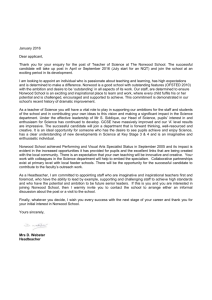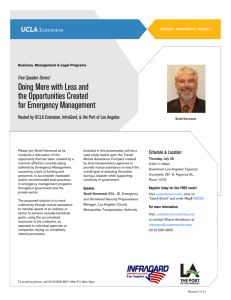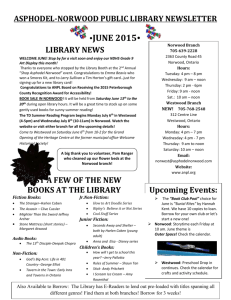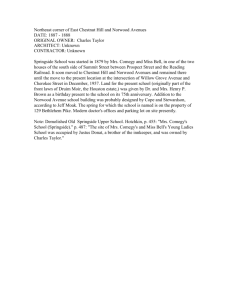Profile of Norwood District High School
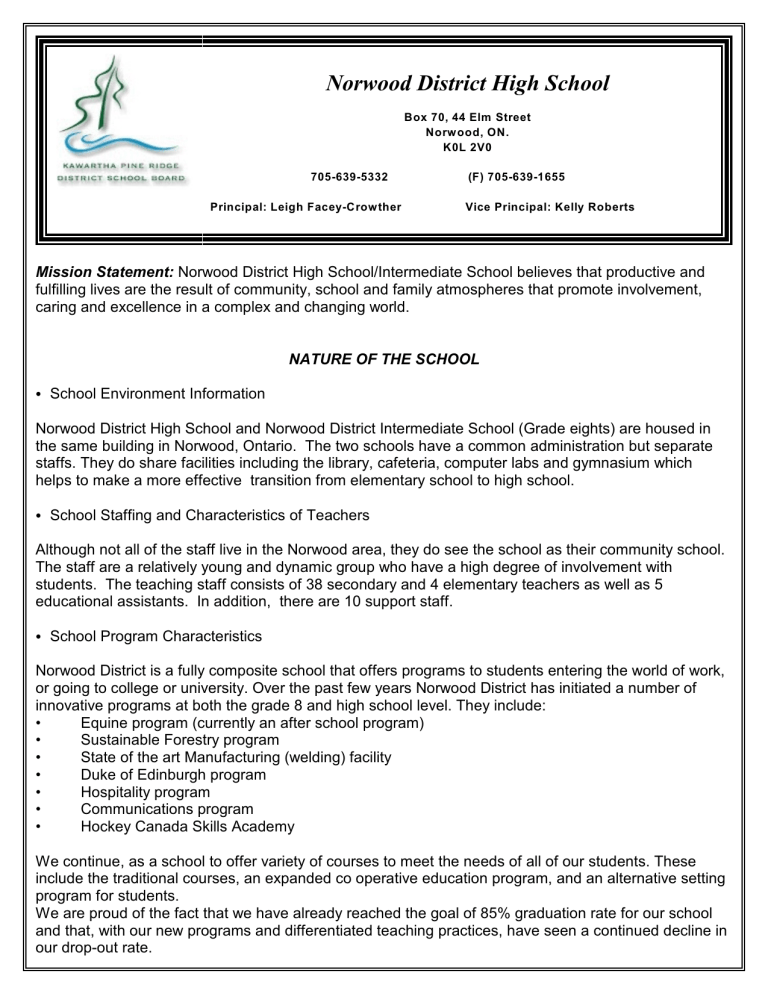
Norwood District High School
Box 70, 44 Elm Street
Norw ood, ON.
K0L 2V0
705-639-5332 (F) 705-639-1655
Principal: Leigh Facey-Crow ther Vice Principal: Kelly Roberts
Mission Statement: Norwood District High School/Intermediate School believes that productive and fulfilling lives are the result of community, school and family atmospheres that promote involvement, caring and excellence in a complex and changing world.
NATURE OF THE SCHOOL
C School Environment Information
Norwood District High School and Norwood District Intermediate School (Grade eights) are housed in the same building in Norwood, Ontario. The two schools have a common administration but separate staffs. They do share facilities including the library, cafeteria, computer labs and gymnasium which helps to make a more effective transition from elementary school to high school.
C School Staffing and Characteristics of Teachers
Although not all of the staff live in the Norwood area, they do see the school as their community school.
The staff are a relatively young and dynamic group who have a high degree of involvement with students. The teaching staff consists of 38 secondary and 4 elementary teachers as well as 5 educational assistants. In addition, there are 10 support staff.
•
•
•
•
•
C School Program Characteristics
Norwood District is a fully composite school that offers programs to students entering the world of work, or going to college or university. Over the past few years Norwood District has initiated a number of
•
• innovative programs at both the grade 8 and high school level. They include:
Equine program (currently an after school program)
Sustainable Forestry program
State of the art Manufacturing (welding) facility
Duke of Edinburgh program
Hospitality program
Communications program
Hockey Canada Skills Academy
We continue, as a school to offer variety of courses to meet the needs of all of our students. These include the traditional courses, an expanded co operative education program, and an alternative setting program for students.
We are proud of the fact that we have already reached the goal of 85% graduation rate for our school and that, with our new programs and differentiated teaching practices, have seen a continued decline in our drop-out rate.
Finally, many of our technology students take advantage of the O.Y.A.P. (Apprenticeship program) and are able to attend both our school and Sir Sanford Fleming as they work towards apprenticeship
• completion.
School Facilities
The last few years have seen a number of improvements made in and around the school. They include:
•
•
•
•
•
•
•
• re-location of the entrance/exit gate in the student parking lot to improve the flow of traffic and the safety of students, vehicles and buses major renovations to several science labs and the main office major renovations to the dust collection system in the construction shop development of a new weight and fitness centre new basketball backboards addition of the Community (computer) Access Lab which may be utilized by the community new state of the art welding and construction shops new sawmill/kiln facility to enhance our forestry program
C Student Services
Norwood High School has an excellent Guidance and Career Education program that prepares students for post-secondary education and employment. Our new and expanded facilities is shared with our coop program and provides a variety of services to meet the needs of all of our students.
ABOUT OUR STUDENTS
C School Population
N.D.H.S. currently houses over 500 secondary students and 88 grade eight. Our students come in from our two elementary schools - Norwood Public School and Havelock-Belmont Public School and also
Peterborough and Hastings schools.
C Student Characteristics
Norwood D.H.S./I.S. is a fully composite school that offers programs in all subject areas and at all levels. Many of our students attend post-secondary schools and/or are very successful in the world of work. Our students receive graduating awards and scholarships. The school presented over $15,000 at graduation, 2002.
C Student Leadership and Organizations
Norwood has a strong tradition of student leadership and involvement. An active student government/athletic council, organizing dances, special events, and fund raising activities, running intramurals; an ambassadors group involved in social causes; and a peer tutoring program assisting younger students; are all examples of the ways Norwood students are involved in the life of the school community.
Several Band ensembles are actively involved in performing concerts at Christmas and in May, at graduation and in assemblies. Our senior concert band performed at the Nationals in Ottawa last May and was awarded a bronze medal.
Our Drama program has grown over the last few years and students and parents enjoyed the production of “Grease” and “The Wiz”.
One of the highlights of the year is the “re-enactment” of either the Civil War or the War of 1812. This is
just another example of our students learning history through re-enactments and this program has now been expanded to other area schools. Several staff, a large number of students and help from the community makes this a very popular event that has been highlighted in several provincial media sources.
Our students have a strong sense of community and support a variety of charities (United Way, Terry
Fox), blood donor clinics and seniors programs. The introduction of a Breakfast Program that supports our academic well-being of our students.
Norwood DHS/IS offers a wide variety of “Knights” athletics including volleyball, soccer, basketball, hockey, wrestling, rugby, curling, and badminton. Three years ago saw the revival of football at our school. The community support of the team was outstanding and the junior team brought home a
COSSA championship last year and shared that honour with our basketball team. Our teams are competitive every year and embrace the Character Education attributes in their play.
SCHOOL ACTION PLAN FOR IMPROVEMENT
The School Action Plan for Improvement is updated on a yearly basis, with input from the school’s parent community, School Council and staff.
Schools use a variety of resources as they review and update their School Action Plan for
Improvement.
• provincial and system assessment results
• the previous School Plan for Improvement
• the current System Action Plan for Improvement
• the Principles of Effective Schools
• school generated data (e.g., surveys)
THE LITERACY TEST
SUMMARY OF PROCESS TO DEVELOP SCHOOL ACTION PLAN
• results delivered to the school
• analysis of individual results
• analysis of test result summary comparing school with Board and Province
• interviews with students whose results were not successful to analyze test situation
• summary of common weaknesses established
• results shared with all staff
• creation of a Literacy Committee composed of staff (grade 8 to 12) from a large cross-section of curriculum
• school action plan for improvement established
KEY FINDINGS:
• over the past year our results have moved by 55% pass rate to a 76% pass rate
• still, the greatest skill weakness in the reading section was the ability to identify indirect information
(inference skills).
• students who failed the reading section often had difficulty in interpreting charts and graphs
ACTION PLAN FOR IMPROVEMENT:
• individual departments will be required to incorporate into their grade nine courses at least two of the following to be determined by the Literacy Committee a) teaching and assigning the paragraph (introductory sentence, 2-4 supporting sentences. b) teaching and assigning supported opinion (introductory paragraph, 3 supporting paragraphs, concluding paragraph) c) teaching and assigning the news report (list possible ideas; students generate assigned number of paragraphs covering who, what, when, where, why, and how) d) teaching and assigning the summary (read and write a summary of so many works; proper punctuation and key points necessary)
• all grade 9 and 10 teachers should be stressing and demanding the following of instructions and should use regular classroom assignments to test students.
• all grade nine mathematics, science and geography teachers should be teaching and assigning readings .
• all grade 9 teachers should be focusing on teaching spelling, grammar, and punctuation.
• all grade nine teachers should be helping students to identify indirect information in text, to make connections and to identify relationships
• all grade 10 teachers should help teachers with test preparation
• guidance and special education departments to review and modify timetables of students who were not successful to include both English and Learning Strategies courses for next year.
• the ALL program (a grade nine reading tutor program) has been running for the past 5 years and has produced excellent results
• a practice literacy test has been run in grade 9 and the results are used to change classroom practice, select students for the after school literacy program and to determine if any students need additional practice
Cross-panel
• grade 7/8/9 teachers will meet to share test results, develop a skills continuum for literacy, and develop units for inclusion in the regular curriculum
• grade 7/8/9 teachers will introduce uninterrupted silent reading programs into the regular curriculum
TARGET SETTING
The target set for the March 2005 Literacy Test is to see the overall school percentage of success move from 67% to 69%. It moved to 76%.
GRADE NINE MATHEMATICS ASSESSMENT
SUMMARY OF PROCESS TO DEVELOP SCHOOL ACTION PLAN
• results delivered to the school
• analysis of individual results
• analysis of test result summary comparing school with Board and Province
• interviews with students whose results were not successful to analyze test situation
• summary of common weaknesses established
• results shared with all staff
• creation of a Numeracy Committee composed of staff (8 to 12) from a large cross-section of curriculum
• plan for improvement established
KEY FINDINGS (2006):
APPLIED STUDENTS
• no students were excluded from the writing of the test
• 44% of the students achieved level 3 (provincial average) compared to 42% KPR Board and
35% provincially. 5% of our students were level 4.
• our weakest areas were Number Sense and Algebra (31% unsuccessful), Analytic
Geometry (32% unsuccessful) and Problem Solving (41% unsuccessful)
• our strongest areas were Knowledge/Understanding (80% successful) and Number
Sense and Algebra (78% successful)
ACADEM IC STUDENTS
• 76% of our students were at or above the provincial average compared to 68% KPR Board and 71% provincially. 6% of our students were level 4.
• areas of strength include Relationships (3% of the students) and Applications (2% of the students) performed at level 4.
• areas of weakness include Measurement and Geometry and Problem Solving
ACTION PLAN FOR IMPROVEMENT:
• teachers of applied mathematics will focus on the areas of Number Sense and Algebra, Analytic
Geometry and Problem Solving.
• teachers of academic mathematics will focus on the areas of Measurement and Geometry, and
Problem Solving
• mathematics teachers will incorporate samples of the test provided by the EQAO at the appropriate times in the curriculum
• the mathematics department will look at the curriculum to insure that the curriculum aligns with the test questions
• grade 10 mathematics teachers will review results of individual students to insure that they are able to meet the expectations of the curriculum.
• guidance and special education departments to review and modify timetables of students who were not successful to insure success in future mathematics courses
Cross-panel
• grade 7/8/9 teachers will meet to share test results, develop a skills continuum for numeracy, develop a common language of mathematics, and develop units for inclusion in the regular curriculum.
TARGETS
• Increase the number of applied students reaching at least level 3 performance from 44% to 45%.
• Increase the number of academic students reaching at least level 3 performance from 76% to 78% and Increase the number of applied students exceeding the provincial average (level 4) from 5 to 6%.
• Increase the number of applied students exceeding the provincial average (level 4) from 5 to 6%.
A copy of the full, detailed School Action Plan for Improvement is sent to the Superintendent of Schools, shared with the School Council, used by the principal in collaboration with staff to monitor and record actions, and kept on file to be made available upon request by parents or media.
